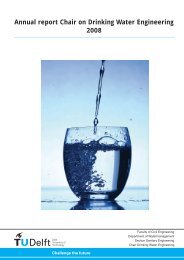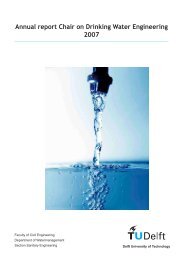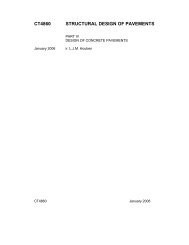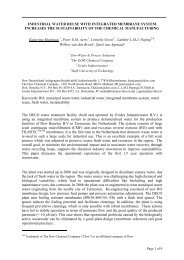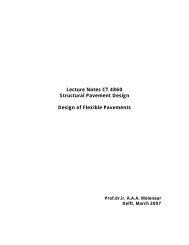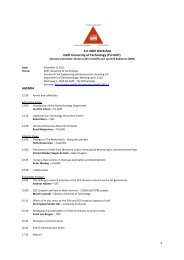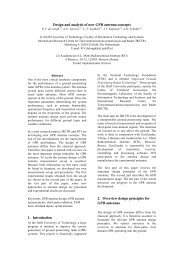CHAPTER 5 CONCRETE PAVEMENTS - TU Delft
CHAPTER 5 CONCRETE PAVEMENTS - TU Delft
CHAPTER 5 CONCRETE PAVEMENTS - TU Delft
Create successful ePaper yourself
Turn your PDF publications into a flip-book with our unique Google optimized e-Paper software.
<strong>CHAPTER</strong> 5<br />
<strong>CONCRETE</strong> <strong>PAVEMENTS</strong><br />
160
5.1 Introduction:<br />
Concrete pavements always require technical provisions to prevent uncontrolled<br />
cracking due to hardening shrinkage of the concrete and due to a decrease of the<br />
temperature. The possible measures are:<br />
- in plain (unreinforced) concrete pavements every 3 to 6 m a transverse joint is<br />
made, and in wide pavements also longitudinal joints are made; this means that<br />
the pavement is divided into concrete slabs<br />
- in reinforced concrete pavements such an amount of reinforcement (0.6 to 0.75%)<br />
is applied, that every 1.5 to 3 m a very narrow crack appears<br />
- in prestressed concrete pavements by prestressing such compressive stresses<br />
are introduced that the resulting flexural tensile stresses in the concrete due to<br />
shrinkage, prestressing, temperature and traffic loadings stay within acceptable<br />
values.<br />
The application of the ‘zero-maintenance’ but very expensive prestressed concrete<br />
pavements is limited to extremely heavily loaded pavements, especially airport<br />
platforms (for instance at Amsterdam Airport Schiphol). Reinforced concrete<br />
pavements, with a noise-reducing and permeable wearing course of porous asphalt<br />
(‘ZOAB’), are nowadays sometimes applied on Dutch motorways. In all other cases,<br />
however, plain concrete pavements are applied and for that reason in this lecture<br />
note only attention is paid to this type of concrete pavement.<br />
More extensive information about the design (and construction) of concrete<br />
pavements can be found in (1,2,3,4,5).<br />
5.2 Structure of plain concrete pavements:<br />
5.2.1 General:<br />
Figure 5.1 shows in general terms the plain concrete pavement structure.<br />
Plain concrete toplayer<br />
Base<br />
Sub-base<br />
Subgrade<br />
Substructure<br />
Figure 5.1: Plain concrete pavement structure.<br />
The toplayer consists of cement concrete, that exhibits an elastic behavior until the<br />
moment of failure. The Young’s modulus of elasticity of the concrete toplayer is much<br />
higher than that of the underlying layers, which results in a great load spreading in<br />
the toplayer and hence in low stresses in the underlying substructure (base plus subbase<br />
plus subgrade).<br />
Because of the great load spreading in the concrete toplayer, for reasons of strength<br />
a base is not (always) necessary. Nevertheless generally a base (with a high<br />
161
esistance to erosion) is applied to prevent as much as possible the loss of support of<br />
the concrete toplayer, which could result in unevenness and/or early cracking of the<br />
concrete. A base is also necessary for carrying the modern, heavy construction<br />
equipment (slipformpaver) for the concrete toplayer.<br />
The sub-base is especially needed to protect the concrete pavement structure<br />
against frost/thaw damage. The minimum thickness of the sub-base is thus<br />
dependent on both the thickness of the overlaying layers and the frost penetration<br />
depth.<br />
5.2.2 Subgrade:<br />
Because of the high Young’s modulus of elasticity of the concrete toplayer the<br />
bearing capacity of the subgrade has only a small effect on the stresses in the<br />
concrete layer due to a traffic loading.<br />
Due to this small effect it is common use in the design of concrete pavement<br />
structures to simply schematize the subgrade into a system of independent vertical<br />
linear-elastic springs with a stiffness (‘modulus of subgrade reaction’) k0 (see 5.3.2).<br />
The bearing capacity of the subgrade (modulus of subgrade reaction) does have a<br />
great effect on the vertical displacements (deflections) of a concrete pavement<br />
structure due to a traffic loading.<br />
Because of the characteristic behavior of a concrete pavement structure and the high<br />
repair costs in case of failure, it is important to use in the design of the concrete<br />
pavement structure a relative low modulus of subgrade reaction, for instance the<br />
value that has a 95% probability of exceeding.<br />
Besides the bearing capacity also the settlement behavior of the subgrade is<br />
important.<br />
Except the connection to bridges, founded on piles, equal settlements of the<br />
subgrade generally are not a problem.<br />
However, by unequal subgrade settlements extra flexural stresses are introduced in<br />
the concrete pavement structure. The magnitude of these stresses is dependent on<br />
the wavelength and amplitude of the settlement pattern (related to the dimensions of<br />
the concrete pavement) and on the velocity of the settlement process (because of<br />
stress relaxation in the cement concrete).<br />
In practice (plain) concrete pavements are only applied on subgrades that do not<br />
exhibit settlements (such as the sand subgrade in the southern and eastern parts of<br />
The Netherlands) or on subgrades with rather limited and uniform settlements (for<br />
instance at Amsterdam Airport Schiphol).<br />
5.2.3 Sub-base:<br />
The sub-base may have the following functions:<br />
- raising the road surface above the level of the surrounding subsoil<br />
- preventing damage of the pavement structure due to frost/thaw action<br />
- temporary storage of rainwater that penetrated into the pavement structure<br />
- soil improvement, i.e. replacement of unsuitable subgrade material<br />
- platform for the construction of the overlaying pavement layers<br />
- spreading the traffic loadings.<br />
162
The thickness of the sub-base is thus dependent on the designed height level of the<br />
road surface, the frost penetration depth (in cold climates), the permeability and<br />
bearing capacity of the subgrade, the traffic loadings (especially during the<br />
construction of the road) and the properties of the sub-base material.<br />
Generally an unbound granular material (like gravel, crusher run, blast furnace slags,<br />
sand etc.) is applied for the sub-base. The grading of the sub-base material should<br />
meet the filter laws at the boundary with the subgrade material and at the boundary<br />
with the unbound base material (if any).<br />
In The Netherlands between the subgrade and the base (nearly) always sand is<br />
applied (because of its availability and the lack of other natural road building<br />
materials), where a distinction is made between ‘sand for sub-base’ and ‘sand for fill’.<br />
‘Sand for fill’ is used at a depth of more than 1 m below the road surface, so below<br />
the depth of frost penetration. It must consist of mineral material in which particles<br />
smaller than 2 µm are present up to a maximum of 8% by mass. The amount of<br />
particles passing the 63 µm sieve must be not more than 50% by mass. The degree<br />
of compaction should be at least 93% MPD (Maximum Proctor Density) and the<br />
average degree of compaction should be at least 98% MPD.<br />
‘Sand for sub-base’ is applied at a depth of less than 1 m below the road surface,<br />
which means that it may be within the frost penetration depth and that it clearly is<br />
subjected to traffic load stresses. Of the particles passing the 2 mm sieve, the<br />
amount of particles passing the 63 µm sieve must be not more than 15% by mass. If<br />
this amount is between 10 and 15% by mass, then, of the particles passing the 2 mm<br />
sieve, the amount of particles passing the 20 µm sieve must be not more than 3% by<br />
mass. The degree of compaction should be at least 95% MPD and the average<br />
degree of compaction should be at least 100% MPD.<br />
Similar to the subgrade, also the bearing capacity of the sub-base has a limited effect<br />
on the stresses in the concrete layer due to a traffic loading and a considerable effect<br />
on the deflections of the concrete pavement structure due to a traffic loading.<br />
In the design of concrete pavement structures the effect of a sub-base generally is<br />
taken into account by means of a certain increase (dependent on the thickness and<br />
Young’s modulus of elasticity of the sub-base) of the modulus of subgrade reaction<br />
(see 5.3.2).<br />
5.2.4 Base:<br />
In The Netherlands mostly a cement-bound base is applied in (plain) concrete<br />
pavements. Like cement concrete also a cement-bound base material is subjected to<br />
shrinkage due to the hardening process and due to a decrease of temperature. Due<br />
to the friction with the underlying layer this shrinkage results in cracking. The more<br />
cement in the base material, the less but wider cracks will occur.<br />
Without measures there will grow an uncontrolled crack pattern in the cement-bound<br />
base, with variable crack distances and crack widths. The major cracks give the risk<br />
of reflection cracking, which means the growth of cracks from the base into the<br />
concrete toplayer.<br />
There are some measures to prevent this reflection cracking:<br />
1. Preventing the adhesion between the cement-bound base and the concrete<br />
toplayer by the application of a ‘frictionless’ layer (plastic or asphalt layer) on top<br />
of the base.<br />
163
2. Not preventing the adhesion between the cement-bound base and the concrete<br />
toplayer, but controlling the cracking in the base by means of:<br />
a. distribution of the construction traffic for the concrete top layer, in such a way<br />
that there will grow a regular pattern of fine cracks in the cement-bound base;<br />
of course the cement-bound base should not be totally destructed by the<br />
construction traffic<br />
b. in case of unreinforced concrete pavements, by weakening the cement-bound<br />
base at regular distances, so that the location of the cracks is fixed (similar to<br />
the joints in the plain cement concrete); the cracks in the cement-bound base<br />
have to be exactly below the joints in the concrete toplayer.<br />
In the first instance there will be a substantial adhesion between the concrete<br />
toplayer and a cement-bound base. However, due to a different displacement<br />
behavior (caused by the temperature variations and the traffic loadings) of the<br />
concrete layer and the base, during time this adhesion will disappear to a great<br />
extent. For reasons of safety therefore in general in the structural concrete<br />
pavement design it is assumed that there exists no adhesion between the<br />
concrete layer and a cement-bound base.<br />
In the design of concrete pavement structures the effect of a cement-bound base in<br />
general is also taken into account by means of an increase (dependent on the<br />
thickness and Young’s modulus of elasticity of the base) of the ‘modulus of subgrade<br />
reaction’ of the subgrade plus the sub-base (see 5.2.3 and 5.3.2).<br />
Because of its high resistance to erosion and reasonable costs usually lean concrete<br />
is applied for the cement-bound base. Lean concrete is a mixture of gravel and sand<br />
(in a ratio of about 2:1), cement (80 to 100 kg/m 3 ) and water. Lean concrete is<br />
manufactured in a concrete plant and then spread and compacted by means of a<br />
slipformpaver. The Young’s modulus of elasticity, after 28 days, of uncracked lean<br />
concrete is 15,000 to 20,000 N/mm 2 .<br />
In plain concrete pavements the thickness of the lean concrete base varies between<br />
150 to 200 mm (roads) and 600 mm (airport platforms). To enable an adequate<br />
support of the slipformpaver for the overlaying concrete pavement at either side of<br />
the pavement the base has to be 0.5 m wider than the concrete pavement.<br />
The evenness of the lean concrete base has to be good (maximum deviation of 15<br />
mm under a 3 m long straightedge) to obtain an overlaying concrete pavement of<br />
rather uniform thickness.<br />
5.2.5 Concrete toplayer:<br />
The concrete mixture of a (plain) concrete pavement is manufactured in a concrete<br />
plant; for big projects a mobile plant close to the works-site is used. The concrete<br />
mixture consists of gravel or crushed stone and sand (in a ratio of about 2:1), cement<br />
(300 to 400 kg/m 3 ) and water; sometimes one or more additives and/or pigments (for<br />
coloring) are added to the mix.<br />
Generally concrete for pavements must fulfil the requirements for environment class<br />
3 (moist environment together with thaw salts) of the VBT 1986. This means that the<br />
water/cement-ratio of the concrete mix may not exceed the value 0.55 (if an airentraining<br />
admixture is used in the mix) or 0.45 (if no air-entraining admixture is<br />
used).<br />
164
In some case gravel may be used as coarse aggregate in the concrete mix. For<br />
heavily trafficked pavements however crushed stone shall be used to improve the<br />
skid resistance. Because of the difference in costs between gravel and crushed stone<br />
in those cases the concrete pavement is sometimes constructed in two sub-layers<br />
(‘wet in wet’, i.e. by means of two slipformpavers closely behind each other), i.e. a<br />
bottom layer of gravel concrete and a 60 to 80 mm thick upper layer of stone<br />
concrete. The alternative of course is to use stone concrete over the whole concrete<br />
pavement thickness, in this case only one slipformpaver is required.<br />
The most important properties (with respect to the design of concrete pavement<br />
structures) of some Dutch concrete qualities are shown in table 5.1.<br />
Generally on heavily loaded concrete pavements, such as motorways and airport<br />
platforms, the concrete quality B45 is used. On lightly loaded pavements (bicycle<br />
tracks, rural roads, etc.) mostly concrete quality B35 and sometimes B45 is applied.<br />
The concrete quality B55 is used for precast elements such as concrete blocks, tiles<br />
and edge restraints (kerbs).<br />
concrete quality<br />
Property B25 B35 B45 B55<br />
Mean cube compressive strength<br />
(N/mm²) after 28 days<br />
33 43 53 63<br />
Characteristic* cube compressive<br />
strength (N/mm²) after 28 days<br />
25 35 45 55<br />
Characteristic* compressive<br />
strength (N/mm²) of cylinders taken<br />
from the pavement after 28 days<br />
20 28 36 44<br />
Characteristic* splitting strength<br />
(N/mm²) after 28 days<br />
Characteristic* flexural tensile<br />
strength (N/mm²):<br />
2.25 2.75 3.25 3.75<br />
after 28 days<br />
3.5 4.2 4.9 5.6<br />
after 90 days<br />
3.9 4.6 5.3 6.0<br />
Dynamic modulus of elasticity<br />
(N/mm²)<br />
30500 32500 34500 36500<br />
Density (kg/m 3 ) 2300 – 2400<br />
Poisson’s ratio 0.15 – 0.20<br />
Coefficient of linear thermal<br />
expansion (°C -1 )<br />
1 x 10 -5 – 1.2 x 10 -5<br />
* 95% probability of exceeding<br />
Table 5.1: Mechanical properties of (Dutch) cement concrete for concrete pavement<br />
structures (2,3).<br />
Extensive information about the manufacturing of the concrete mix and the<br />
construction of concrete pavements can be found in (4,5,6).<br />
Immediately after construction the fresh concrete has to be protected against drying<br />
through a curing compound, wet jute bags or a roof structure.<br />
In plain concrete pavements furthermore joints have to be realized within 12 to 24<br />
hours after construction of the pavement. This is necessary to prevent uncontrolled<br />
165
(‘wild’) cracking, due to the cooling down of the fresh concrete in the first night after<br />
construction or due to a strong temperature decrease of the hardened elastic<br />
concrete, because of friction with the underlying layer. One distinguishes:<br />
- in the transverse direction: contraction joints, expansion joints (at the end of<br />
the concrete pavement, for instance in front of bridges) and construction joints<br />
(at the end of a daily production)<br />
- in the longitudinal direction: contraction joints and construction joints (between<br />
two lanes of concrete placement).<br />
Through the transverse and longitudinal contraction joints a plain concrete pavement<br />
is divided into concrete slabs. To limit the temperature gradient stresses (see 5.3.3)<br />
the slabs should be more or less square with a maximum horizontal dimension<br />
smaller than about 5 m (on roads) and 7.5 m (on airports) respectively.<br />
Figure 5.2 shows an example of a plain concrete pavement for a two-lane industrial<br />
road.<br />
Figure 5.2: Concrete slab configuration, with dowel bars and ty bars, of a two-lane<br />
industrial road.<br />
For a better load transfer, dowel bars are applied in the transverse contraction joints<br />
of heavier loaded concrete pavements at mid-height of the concrete slab. A dowel<br />
bar is a steel bar with a diameter of about 10% of the concrete pavement thickness<br />
(normally 25 mm in road pavements and 32 mm in airport pavements) and a length of<br />
500 to 600 mm. The distance between the dowel bars is 300 to 500 mm. The dowel<br />
bars should by no means obstruct the horizontal movements of the concrete slabs<br />
due to the variation of the absolute temperature and therefore they have a<br />
bituminous or plastic coating to prevent adhesion to the concrete (figure 5.3).<br />
166
Figure 5.3: Transverse contraction joint with dowel bar.<br />
In longitudinal contraction joints so-called ty bars are applied to prevent two adjacent<br />
rows of concrete slabs to float away from each other due to variation of the absolute<br />
temperature. The ty bars are located at mid-height, or even somewhat higher, of the<br />
concrete slab. The profiled steel ty bars have a diameter of 16 mm and a length of at<br />
least 600 mm. At both ends the ty bars are fixed into the concrete, however the<br />
central one-third part of the ty bar has a coating (which prevents bond to the<br />
concrete) to distribute the occurring movements of the concrete slabs due to varying<br />
absolute temperatures over a sufficient length so that no flow of the ty bar steel<br />
occurs (figure 5.4). In longitudinal contraction joints normally 3 ty bars per concrete<br />
slab length are applied (see figure 5.2).<br />
Figure 5.4: Longitudinal contraction joint with ty bar.<br />
Contraction joints are made by sawing a 3 mm wide cut into the hardening concrete.<br />
This sawing has to be done as soon as possible and certainly within 24 hours after<br />
the placement of the concrete. The depth of the saw cut for longitudinal contraction<br />
joints should be 40 to 45% of the concrete thickness and for transverse contraction<br />
joints about 35% of the concrete thickness. By these saw cuts the concrete is<br />
weakened to such an extent that the inevitable cracks (due to shrinkage of the<br />
hardening concrete or a decrease of the absolute temperature of the hardened<br />
concrete) will appear below the saw cuts.<br />
The joints may remain open (which is usually done at rural roads) or they may be<br />
filled. In this latter case by further sawing the joints have to be widened (e.g. to 8 mm)<br />
to a certain depth to enable filling of the joints (with a bituminous material or with<br />
special hollow plastic profiles) and to limit the strains in the joint-filling material at<br />
changing joint widths due to temperature variations.<br />
On roads the thickness of plain concrete pavements varies between 180 mm (bicycle<br />
tracks) and 300 mm (motorways). On airports and other very heavily loaded<br />
pavements a plain concrete pavement with a thickness up to 450 mm is applied.<br />
167
5.3 Stresses and displacements in plain concrete pavements:<br />
5.3.1 Introduction:<br />
The structural design of plain concrete pavements mainly concerns the analysis of<br />
the occurring (flexural) tensile stresses in the concrete pavement and the allowable<br />
(flexural) tensile stresses, taking into account fatigue of the concrete. The occurring<br />
(flexural) tensile stresses are mainly due to the traffic loadings and to the temperature<br />
gradients.<br />
In this chapter some analytical models for the calculation of the occurring flexural<br />
tensile stresses in plain concrete pavements are presented. However first the<br />
modulus of subgrade reaction ko is discussed and the increase of this ko-value<br />
through a sub-base and a base.<br />
5.3.2 Modulus of substructure reaction:<br />
One of the input parameters in the design of concrete pavement structures is the<br />
bearing capacity of the substructure (base plus sub-base plus subgrade). Generally<br />
the complete substructure is modeled as a dense liquid, which means that in the<br />
substructure no shear stresses can occur. The bearing capacity of the substructure<br />
thus is expressed as the ‘modulus of substructure reaction’ k, which is defined as<br />
(figure 5.5):<br />
k = p / w<br />
(5.1)<br />
where: k = modulus of substructure reaction (N/mm 3 )<br />
p = vertical stress (N/mm 2 ) at the top of the substructure<br />
w = vertical displacement (deflection) (mm) at the top of the<br />
substructure<br />
Figure 5.5: Definition of the ‘modulus of substructure reaction’ k.<br />
In principal the modulus of substructure reaction k has to be determined in situ by<br />
means of a plate bearing test. However, for reasons of costs, plate bearing tests are<br />
not always done. Then the modulus of substructure reaction has to be determined in<br />
an indirect way, with an increasing possibility of inaccuracy.<br />
Table 5.2 gives an indication of the value of the modulus of subgrade reaction ko. For<br />
a certain subgrade that ko-value should be chosen that represents the bearing<br />
capacity for the actual moisture content, degree of compaction and grading.<br />
168
Subgrade k0 (N/mm 3 )<br />
Well graded gravel and gravel/sand-mixtures, hardly any fine material<br />
Poor graded gravel, hardly any fine material<br />
Gravel/sand/clay-mixtures<br />
Well graded sand and sand with gravel, hardly any fine material<br />
Poor graded sand, hardly any fine material<br />
Sand/clay-mixtures<br />
Very fine sand, sand with loam<br />
Vast clay<br />
Weak clay and peat<br />
Table 5.2: Rough k0-values for various types of subgrade (2).<br />
0.08 – 0.13<br />
0.08 – 0.13<br />
0.05 – 0.13<br />
0.05 – 0.10<br />
0.04 – 0.10<br />
0.03 – 0.08<br />
0.03 – 0.05<br />
0.01 – 0.03<br />
0.00 – 0.01<br />
When the CBR-value of the subgrade is known, then an indication of the ko-value can<br />
also be obtained by means of figure 5.6.<br />
Figure 5.6: Rough relationship between ko and CBR for various types of subgrade (2)<br />
As already mentioned in paragraph 5.2, generally a sub-base and/or a base are<br />
constructed over the subgrade. The effect of these layers can be estimated by means<br />
of figure 5.7.<br />
The k-value at the top of a layer is found from the k-value at the top of the underlying<br />
layer and the thickness hf (mm) and the dynamic modulus of elasticity Ef (N/mm²)<br />
(table 5.3) of the layer under consideration. This procedure has to be repeated for<br />
each (sub-)base layer, so at the end the ‘modulus of substructure reaction’ k on top<br />
of the substructure, i.e. directly beneath the concrete top layer, is found.<br />
169
Example<br />
Sand subgrade: ko = 0.045 N/mm 3<br />
Sand sub-base, hf = 500 mm, Ef = 100 N/mm²: at top of sub-base k = 0.055 N/mm 3<br />
Lean concrete base, hf = 150 mm, Ef = 8000 N/mm²: at top of base k = 0.105 N/mm 3<br />
The k-value of 0.105 N/mm 3 is used by the Dutch State Highway Authorities in the<br />
structural design of concrete pavements for motorways.<br />
Figure 5.7: Nomograph for the determination of the k-value on top of a<br />
(sub-)base layer (1).<br />
Material Ef (N/mm²)<br />
Sand<br />
Gravel/sand<br />
Crusher run<br />
Crushed masonry<br />
Crushed concrete<br />
Mix granulate<br />
Blast furnace slags: granular<br />
hydraulic<br />
Sandcement*<br />
Lean concrete*<br />
* uncracked<br />
100 - 200<br />
200 - 400<br />
300 - 600<br />
200 - 300<br />
400 - 1000<br />
300 - 500<br />
400 - 800<br />
2000 - 3000<br />
6000 - 12000<br />
15000 - 20000<br />
Table 5.3: Rough Ef-values for some (sub-)base materials.<br />
170
5.3.3 Stresses due to temperature variations:<br />
Temperature variations lead to stresses in the concrete top layer. These stresses can<br />
be distinguished into (figure 5.8):<br />
1. stresses due to a temperature change ∆T which is constant over the thickness<br />
of the concrete layer<br />
2. stresses due to a temperature gradient ∆t which is constant over the thickness<br />
of the concrete layer<br />
3. stresses due to an irregular temperature over the thickness of the concrete<br />
layer.<br />
Figure 5.8: Temperature in the concrete toplayer in case of heating at the surface.<br />
A regular temperature increase or decrease ∆T leads to compressive and tensile<br />
stresses respectively in the concrete toplayer due to friction over the underlying layer.<br />
However, for plain concrete pavements (that generally consist of slabs with both a<br />
length and a width smaller than 5 m (roads) or 7.5 m (airports) these stresses are<br />
such small that they can be neglected.<br />
The irregular temperature results in internal concrete stresses, which are only<br />
relevant for very thick concrete slabs. For normal concrete slab thicknesses they also<br />
can be neglected.<br />
On the contrary, the temperature gradients ∆t cause flexural stresses in the concrete<br />
slab, which are for plain concrete pavements in the same order of magnitude as<br />
those caused by the traffic loadings, and thus cannot be neglected at all.<br />
The temperature gradient ∆t is defined as (figure 5.8):<br />
T Tb<br />
∆ t =<br />
(5.2)<br />
h<br />
t −<br />
where: Tt = temperature (°C) at the top of the concrete layer<br />
Tb = temperature (°C) at the bottom of the concrete layer<br />
h = thickness (mm) of the concrete layer<br />
For the structural design of plain concrete pavements in The Netherlands only the<br />
positive temperature gradients are relevant because:<br />
171
1. positive temperature gradients mainly occur during the day, together with the<br />
(majority of the) heavy truck traffic<br />
2. both positive temperature gradients and the traffic loading cause flexural tensile<br />
stresses at the bottom of the concrete slab at the most critical locations of the<br />
slab.<br />
A positive temperature gradient causes warping of a concrete slab. Due to the dead<br />
weight of the concrete slab there are flexural tensile stresses at the bottom of the<br />
slab. These stresses are called ‘warping stresses’.<br />
These exist several theories for the calculation of the flexural tensile stresses in<br />
concrete slabs due to positive temperature gradients, for instance those of<br />
Westergaard-Bradbury and Eisenmann (1,4).<br />
In the Dutch VNC-method for the structural design of plain concrete pavements<br />
however a somewhat different model is used, because one has realized that the most<br />
critical point of the pavement structure is somewhere at an edge of the concrete slab.<br />
At the edges there is by definition a uni-axial stress situation (only stresses parallel to<br />
the edge and no stress perpendicular to the edge). For the calculation of the<br />
temperature gradient stresses this means that only a concrete beam (with unit width)<br />
needs to be taken into account and not an entire concrete slab (1,2,7).<br />
In the case of a small positive temperature gradient ∆t the warping of the concrete<br />
slab along the edge is smaller than the compression of the substructure<br />
(characterized by the modulus of substructure reaction k) due to the deadweight of<br />
the concrete slab. This implies that the concrete slab remains fully supported. The<br />
flexural tensile stress σt at the bottom of the concrete slab in the center of a slab edge<br />
can then be calculated by means of the equation:<br />
h⋅∆t<br />
σ t = α E<br />
(5.3)<br />
2<br />
where: h = thickness (mm) of the concrete slab<br />
∆t = small positive temperature gradient (°C/mm)<br />
α = coefficient of linear thermal expansion (°C -1 )<br />
E = Young’s modulus of elasticity (N/mm²) of concrete<br />
At positive temperature gradients greater than a certain limit value l t ∆ the slab’s<br />
edge looses contact with the substructure and is only supported at its ends over a<br />
certain support length. In this case the flexural tensile stress σt at the bottom of the<br />
concrete slab in the center of a slab edge follows from the equation:<br />
σt = 1.8 * 10 -5 L ’2 /h (5.4)<br />
where: h = thickness (mm) of the concrete slab<br />
L ’ = slab span (mm) in longitudinal or transverse direction:<br />
'<br />
L = L − 3<br />
h<br />
k ∆t<br />
with: L = slab length or width (mm)<br />
k = modulus of substructure reaction (N/mm 3 )<br />
∆t = great positive temperature gradient (°C/mm)<br />
172
The value of the limit temperature gradient ∆tl follows from equalizing the equations<br />
5.3 and 5.4 for both the center of the longitudinal slab edge and the center of the<br />
transverse slab edge.<br />
5.3.4 Stresses due to traffic loadings:<br />
The basic theory for the structural design of plain concrete pavements has been<br />
developed by Westergaard in 1926 (8). Westergaard considers a single, fully<br />
supported slab (without any load transfer to adjacent slabs) of the concrete<br />
pavement. The slab is resting on an elastic foundation, i.e. vertical elastic springs<br />
with a stiffness k (the modulus of substructure reaction k, see 5.3.2).<br />
Westergaard developed equations for the maximum flexural tensile stress in the<br />
concrete slab and the maximum vertical displacement (deflection) of the concrete<br />
slab due to a single wheel load, located in the interior (middle), along the edge or in a<br />
corner of the slab (figure 5.9). In the cases that the single wheel load is in the interior<br />
or along the edge of the slab, the flexural tensile stress is maximal at the bottom of<br />
the slab in the center of the wheel load. In the case that the single wheel load is in a<br />
corner of the slab, the flexural tensile stress is maximum at the top of the slab at<br />
some distance (around 1 m) of the corner.<br />
Figure 5.9: Positions of the load in Westergaard’s theory.<br />
The edge loading case is most important for the structural design of plain concrete<br />
pavements. There exist numerous Westergaard-equations for this loading case, but<br />
the most correct equations (which yield nearly the same result) are the following<br />
‘new’ Westergaard-equations from 1948 (9,10):<br />
circular loading area<br />
( 1 + υ)<br />
( 3 + υ)<br />
3<br />
3 P ⎧ ⎛ E h ⎞ 4 1 − υ<br />
σ =<br />
⎨l<br />
n ⎜<br />
⎟ + 1.<br />
84 − υ + + 1.<br />
18 2<br />
4<br />
π h ⎩ ⎝100<br />
k a ⎠ 3 2<br />
semi-circular loading area<br />
( 1 + υ)<br />
( 3 + υ)<br />
( ) ⎬<br />
⎭ ⎫ a<br />
1 + υ<br />
2 (5.5)<br />
3<br />
3 P ⎪⎧<br />
⎛ E h ⎞ 4<br />
a ⎪⎫<br />
2<br />
σ =<br />
⎨l<br />
n<br />
+ − + ( + ) ⎬<br />
⎪⎩<br />
⎜<br />
⎟ 3.<br />
84 υ 0.<br />
5 1 2 υ<br />
(5.6)<br />
2<br />
4<br />
π h ⎝100<br />
k a2<br />
⎠ 3<br />
l ⎪⎭<br />
l<br />
173
where:<br />
σ = flexural tensile stress (N/mm²)<br />
P = single wheel load (N)<br />
p = contact pressure (N/mm²)<br />
a =<br />
P<br />
= radius (mm) of circular loading area<br />
π p<br />
a2<br />
=<br />
2 P<br />
π p<br />
= radius (mm) of semi-circular loading area<br />
E = Young’s modulus of elasticity (N/mm²) of concrete<br />
υ = Poisson’s ratio of concrete<br />
h = thickness (mm) of concrete layer<br />
k = modulus of substructure reaction (N/mm 3 )<br />
3<br />
E h<br />
l = 4<br />
2<br />
12( 1−<br />
υ ) k<br />
= radius (mm) of relative stiffness of concrete layer<br />
It follows from the equations 5.5 and 5.6 that in the case of an edge loading on a<br />
single concrete slab the maximum flexural tensile stress is mainly dependent on the<br />
magnitude of the single wheel load P and the thickness h of the concrete slab, the<br />
other factors are of minor importance.<br />
It is remarked that the size (length and width) of the concrete slab is not included in<br />
the equations 5.5 and 5.6 because they are only valid for rather big concrete slabs,<br />
with horizontal dimensions of at least 8ℓ * 8ℓ (ℓ = radius of relative stiffness of the<br />
concrete slab). The concrete slabs of modern plain concrete pavements do not fulfil<br />
this requirement, nevertheless the equations 5.5 and 5.6 are used in most current<br />
design methods to calculate the traffic load stresses.<br />
Pickett and Ray have transformed the Westergaard-equations into influence charts.<br />
These charts also allow the determination of the flexural tensile stress and the<br />
deflection due to complex load systems, such as dual wheel tyres, tandem and triple<br />
axles, and airplane gears.<br />
In figure 5.10 the influence chart of Pickett and Ray for the bending moment along<br />
the slab edge is shown. In this influence chart the wheel load contact area has to be<br />
drawn on scale; to this end the radius of relative stiffness (l) of the concrete toplayer<br />
is drawn as a reference.<br />
The flexural tensile stress σ at the bottom of the concrete layer due to a wheel load P<br />
is found from the influence chart for the bending moment M by means of the<br />
equation:<br />
2 ( N/<br />
mm )<br />
2<br />
M 6 p l N<br />
σ = =<br />
(5.7)<br />
2<br />
1 2<br />
h<br />
10000 h<br />
6<br />
where: p = contact pressure (N/mm 2 ) of wheel load P<br />
l = radius (mm) of relative stiffness of concrete layer<br />
h = thickness (mm) of concrete layer<br />
N = number of blocks at the chart, covered by wheel load P<br />
174
Figure 5.10: Influence chart of Pickett and Ray for the bending moment along the<br />
slab edge.<br />
175
The equations 5.5 and 5.6 and figure 5.10 are valid for the calculation of flexural<br />
tensile stresses due to traffic loadings in a single concrete slab. However, in reality a<br />
plain concrete pavement consists of a number of concrete slabs with joints between<br />
them. The load transfer in these joints is dependent on the joint width (which<br />
depends on the slab length), the amount of traffic and the type of joint construction<br />
(which means: aggregate interlock, ty bars and dowel bars).<br />
Teller and Sutherland have defined the total load transfer in a joint as follows (11):<br />
W<br />
=<br />
2w<br />
u<br />
100 (5.8)<br />
wl<br />
+ wu<br />
where: W = joint efficiency (%) related to deflections<br />
wl = deflection (mm) at the joint edge of the loaded concrete slab<br />
wu = deflection (mm) at the joint edge of the unloaded concrete slab<br />
In joints of plain concrete pavements without dowel bars the joint efficiency W<br />
decreases from 70-90% just after construction to 10-30% at long term due to the<br />
polishing effect of the repeated traffic loadings on the concrete of the joint sides. In<br />
structural design calculations for these joints without dowel bars the safe value W =<br />
0% (i.e. a free edge) generally is used.<br />
In joints with dowel bars at long term there remains a joint efficiency W of 50-60%.<br />
Similar to equation 5.8, however, the joint efficiency can also be defined as (12):<br />
W<br />
'<br />
= 100<br />
σ<br />
l<br />
2 σ<br />
u<br />
+ σ<br />
u<br />
Where: W ‘ = joint efficiency (%) related to flexural stresses in the concrete slab<br />
σl = flexural tensile stress (N/mm 2 ) at the joint edge of the loaded<br />
concrete slab<br />
σu = flexural tensile stress (N/mm 2 ) at the joint edge of the unloaded<br />
concrete slab<br />
The joint efficiency W ‘ with respect to flexural stresses appears to be (much) smaller<br />
than the joint efficiency W with respect to deflections, as is illustrated in figure 5.11.<br />
(5.9)<br />
Figure 5.11: Flexural stresses related to deflections for doweled concrete slabs (12).<br />
176
The load transfer in joints can be incorporated in the design of plain concrete<br />
pavement structures by means of a reduction of the actual wheel load Pact to the<br />
wheel load P (to be used in equation 5.5 or 5.6) according to:<br />
⎛ W ⎞<br />
P = ( 1 − 1/<br />
2 W / 100)<br />
Pact<br />
= ⎜1<br />
− ⎟ Pact<br />
(5.10)<br />
⎝ 200 ⎠<br />
respectively<br />
'<br />
⎛ W ' ⎞<br />
( 1 − 1/<br />
2 W / 100)<br />
Pact<br />
= ⎜1<br />
− Pact<br />
P =<br />
⎟<br />
⎝ 200 ⎠<br />
(5.11)<br />
In analytical design methods, which are primarily based on a correlation between<br />
occurring and allowable flexural tensile stresses in the concrete pavement, equation<br />
5.11 should be used (instead of equation 5.10).<br />
Example<br />
transverse contraction joint with dowel bars: say W = 60%<br />
equation 5.8: wu = 0.43 wl<br />
figure 5.11: σu = 0.17 σl<br />
equation 5.9: W’= 30%<br />
equation 5.11: P = 0.85 Pac<br />
5.4 VNC Design method:<br />
5.4.1 General:<br />
In this chapter the current Dutch design method for plain concrete pavements is<br />
briefly described. This analytical design method has been developed by the<br />
Netherlands Cement Industry Association (2).<br />
The design model used in the VNC method for plain concrete pavements is shown in<br />
figure 5.12. In the model two possibly critical locations of the most heavily loaded<br />
traffic lane are indicated:<br />
• ZR = center of the longitudinal edge of the concrete slab (free edge or longitudinal<br />
joint)<br />
• VR = center of the wheel track at the transverse joint with load transfer.<br />
Two design criteria are used in the structural design of a plain concrete pavement:<br />
1. a strength criterion, i.e. preventing the concrete pavement for cracking; the<br />
required thickness of the concrete pavement is found from a strength criterion<br />
which on one hand is determined by the occurring flexural tensile stresses<br />
under traffic and temperature gradient loadings and on the other hand by the<br />
fatigue strength of the concrete.<br />
2. a stiffness criterion, i.e. preventing the development of longitudinal<br />
unevenness at the transverse joints (so-called joint-faulting): the required<br />
thickness of the concrete pavement is found from a stiffness criterion which on<br />
one hand is determined by the occurring deflection at the transverse joints<br />
under traffic loading and on the other hand by the allowable deflection.<br />
177
Figure 5.12: Design model for plain concrete pavements in the VNC method.<br />
First of all a plain concrete pavement structure has to be assumed, which means that<br />
the length, width and thickness of the concrete slabs, the concrete quality, the type of<br />
joints, the thickness and modulus of elasticity of the base and sand sub-base, the<br />
modulus of subgrade reaction etc. have to be chosen. If it appears after the<br />
calculation that the assumed pavement structure does not fulfil the technical and/or<br />
economical requirements, then the analysis has to be repeated for a modified<br />
pavement structure. The flow diagram of the VNC design procedure is shown in<br />
figure 5.13.<br />
This paragraph only deals with the technical aspects of the VNC design procedure,<br />
the economical aspects will not be discussed.<br />
5.4.2 Traffic loading:<br />
First the cumulative number of heavy (truck) axle load repetitions on the most heavily<br />
loaded traffic lane (the design lane) during the desired pavement life (20 tot 40 years)<br />
has to be determined.<br />
Only part of this cumulative number of heavy axle load repetitions is driving in the<br />
center of the wheel track, point VR in figure 5.12 (on roads 40% to 50%) or exactly<br />
over the longitudinal edge or longitudinal joint, point ZR in figure 5.12 (0% to 15%,<br />
depending on the geometry of the road).<br />
Furthermore the axle load or wheel load frequency distribution of the heavy (truck)<br />
traffic has to be known or assumed. This wheel load frequency distribution has to be<br />
as realistic as possible: underestimation of the actual wheel loadings may lead to<br />
early and serious structural damage (cracking) of the plain concrete pavement<br />
because of the susceptibility of concrete for overloading (brittle material behavior).<br />
For illustration some theoretical axle/wheel-load frequency distributions, deducted<br />
from actual axle load measurements on Dutch motorways, are given in table 5.4.<br />
178
Figure 5.13: Flow diagram of the VNC design procedure for plain concrete<br />
pavements (2).<br />
179
Axle load<br />
group<br />
(kN)<br />
Wheel load<br />
group<br />
(kN)<br />
Frequency distribution (%)<br />
Light traffic Medium traffic Heavy traffic<br />
0-20 0-10 7.60 5.40 4.00<br />
20-40 10-20 25.00 22.00 15.00<br />
40-60 20-30 30.00 29.00 26.00<br />
60-80 30-40 18.00 20.00 27.00<br />
80-100 40-50 11.00 12.00 14.00<br />
100-120 50-60 6.10 7.70 8.40<br />
120-140 60-70 1.80 3.00 4.40<br />
140-160 70-80 0.41 0.75 1.00<br />
160-180 80-90 0.07 0.10 0.12<br />
>180 >90 0.02 0.05 0.08<br />
Table 5.4: Representative axle/wheel-load distributions of trucks on Dutch motorways<br />
(3).<br />
5.4.3 Temperature gradients:<br />
The VNC design method includes a standard frequency distribution for the (positive)<br />
temperature gradients within the concrete pavement. This distribution (table 5.5) can<br />
be used in the design of plain concrete pavements for roads, bus bays etc. On<br />
heavily loaded airports and industrial yards the temperature gradients will be<br />
somewhat smaller because of the thicker concrete slabs.<br />
Temperature gradient ∆t<br />
(°C/mm)<br />
0.00<br />
0.01<br />
0.02<br />
0.03<br />
0.04<br />
0.05<br />
≥ 0.06<br />
Frequency<br />
distribution (%)<br />
71<br />
17<br />
6<br />
3<br />
2<br />
1<br />
0<br />
Table 5.5: Standard temperature gradient frequency distribution according to the<br />
VNC method (2).<br />
5.4.4 Strength criterion:<br />
In the two possibly critical locations of the concrete slab (VR and ZR, see figure 5.12)<br />
the temperature gradient stress σti has to be calculated for every positive temperature<br />
gradient ∆ti according to the procedure described in paragraph 5.3.3.<br />
Also in the locations VR and ZR the traffic load stress σvi has to be calculated for<br />
every wheel load Pi by means of the appropriate Westergaard equation (eq. 5.5 or<br />
5.6), taking into account the load transfer (if any) at the slab edge under<br />
consideration (joint efficiency W ’ , eq. 5.11).<br />
180
Next a fatigue damage analysis is carried out for the locations VR and ZR by<br />
calculating the allowable number of load repetitions Ni for each combination of wheel<br />
load Pi and temperature gradient ∆ti. In the damage analysis the following concrete<br />
fatigue relationship (50% fatigue curve, so an average relationship) is used:<br />
12.<br />
903 ( 0.<br />
995 − σ max / fbtg)<br />
i<br />
= with 0.<br />
5 ≤ σ / fbtg ≤<br />
1.<br />
000 − 0.<br />
7525 σ / fbtg<br />
log N i<br />
max<br />
min<br />
where:<br />
i<br />
0.<br />
833<br />
(5.12)<br />
Ni = allowable number of repetitions of wheel load Pi i.e. the traffic load<br />
stress σvi until failure when a temperature gradient stress σti is present<br />
σmin i = minimum occurring flexural tensile stress (= σti)<br />
σmaxi = maximum occurring flexural tensile stress (= σvi + σti)<br />
fbtg = average flexural tensile strength (N/mm 2 ) of unreinforced (plain)<br />
concrete under loading of short duration:<br />
fbtg = 1.4 (1.6 – h/1000) (1.05 + 0.05B) (5.13)<br />
where: h = thickness (mm) of the concrete slab<br />
B = characteristic cube compressive strength (N/mm 2 ) after 28<br />
days (see table 5.1)<br />
The design criterion (i.e. cracking occurs) is the cumulative damage law of Palmgren-<br />
Miner:<br />
n<br />
i<br />
∑ = 1.0 (5.14)<br />
i N i<br />
where:<br />
ni = occurring number of repetitions of wheel load Pi i.e. the traffic load<br />
stress σvi during the pavement life when a temperature gradient stress<br />
σti is present<br />
NI = allowable number of repetitions of wheel load Pi i.e. the traffic load<br />
stress σvi until failure when a temperature gradient stress σti is present<br />
5.4.5 Stiffness criterion:<br />
To prevent longitudinal unevenness (joint faulting) at the transverse joints in the plain<br />
concrete pavement the deflection of the transverse edge in the wheel track (location<br />
VR in figure 5.12) due to the traffic loading should be limited. According to<br />
Westergaard the deflection of the transverse edge is (2,13):<br />
⎛ W ⎞ ⎛ P ⎞<br />
wl = λ ⎜1<br />
− ⎟ ⎜ 2 ⎟<br />
(5.15)<br />
⎝ 200 ⎠ ⎝ kl ⎠<br />
181
where:<br />
wl = deflection (mm) of the transverse edge of the loaded concrete slab<br />
λ = parameter (-); in the case of one single wheel load on the concrete slab<br />
and a Poisson’s ratio υ of concrete = 0.15 the λ-value is 0.431<br />
W = joint efficiency (%) with respect to deflections (eq. 5.8 and 5.10)<br />
P = wheel load (N); in the VNC method P = 50 kN = 50,000 N has to be<br />
used<br />
k = modulus of substructure reaction (N/mm 3 )<br />
l = radius of relative stiffness (mm) of the concrete slab<br />
The allowable deflection is dependent on the traffic loading:<br />
w l = 4.8 e -0.35 log neq . (5.16)<br />
where:<br />
w l = allowable deflection (mm) of the transverse edge of the loaded concrete<br />
neq<br />
slab<br />
= cumulative number of equivalent 50 kN wheel load repetitions during the<br />
pavement life, calculated with the equation:<br />
n<br />
eq<br />
∑<br />
= i<br />
where:<br />
( P 50)<br />
i<br />
4<br />
/ n<br />
(5.17)<br />
i<br />
Pi = wheel load (kN)<br />
ni = number of repetitions of wheel load Pi during the pavement life<br />
The design criterion with respect to the stiffness of the plain concrete pavement is:<br />
w l ≤ l<br />
5.5 References:<br />
w (5.18)<br />
1. Houben, L.J.M.<br />
Structural Design of Pavements – Part IV: Design of Concrete Pavements<br />
Lecture Notes CT4860, Faculty of Civil Engineering and Geosciences, <strong>TU</strong><br />
<strong>Delft</strong>; <strong>Delft</strong> - 2003<br />
2. Manual for Concrete Roads (in Dutch)<br />
Cement Industry Association (VNC); ‘s-Hertogenbosch - 1993<br />
3. Manual for Road Construction – Pavement Design (in Dutch), 4 th edition<br />
Ministry of Transport, Public Works and Water Management, Road and<br />
Hydraulic Engineering Division; <strong>Delft</strong> - 1998<br />
182
4. Eisenmann, J.<br />
Concrete Pavements – Design and Construction (in German)<br />
Wilhelm Ernst & Sohn; Berlin/Munich/Dϋsseldorf - 1979<br />
5. Vollpracht, A., H. Eifert, O. Hersel and W. Knopp<br />
Road Construction Today – Concrete Pavements (in German), 4 th edition<br />
Bundesverband der Deutschen Zementindustrie; Köln - 1995<br />
6. Concrete Roads in Practice (in Dutch)<br />
Association of Concrete Road Contractors; VCW/CROW; Ede - 1994<br />
7. Leewis, M.<br />
Theoretical knowledge leads to practical results (in Dutch)<br />
Journal ‘BetonwegenNieuws’ no. 89, September 1992, pp. 20-22<br />
8. Westergaard, H.M.<br />
Stresses in Concrete Pavements Computed by Theoretical Analysis<br />
Public Roads, Vol. 7, no. 2, 1926<br />
9. Westergaard, H.M.<br />
New Formulas for Stresses in Concrete Pavements of Airfields<br />
ASCE, Transactions, Vol. 113, 1948<br />
10. Ioannides, A.M., M.R. Thompson and E.J. Barenberg<br />
The Westergaard Solutions Reconsidered<br />
Workshop on Theoretical Design of Concrete Pavements, 5-6 June 1986,<br />
Epen, The Netherlands<br />
Record 1; CROW; Ede - 1987<br />
11. Teller, L.W. and E.J. Sutherland<br />
A Study of Action of Several Types of Transverse and Longitudinal Joint<br />
Design<br />
Public Roads, Vol. 17, no. 7, 1936<br />
12. Barenberg, E.J. and D.M. Arntzen<br />
Design of Airport Pavements as Affected by Load Transfer and Support<br />
Conditions<br />
Proceedings 2 nd International Conference on Concrete Pavement Design,<br />
Purdue University, West Lafayette, Indiana, USA, 1981, pp. 161-170<br />
13. Leewis, M. and H.E. van der Most<br />
The stiffness criterion for plain concrete pavements (in Dutch)<br />
Journal ‘BetonwegenNieuws’ no. 58, December 1984, pp. 12-16<br />
183



